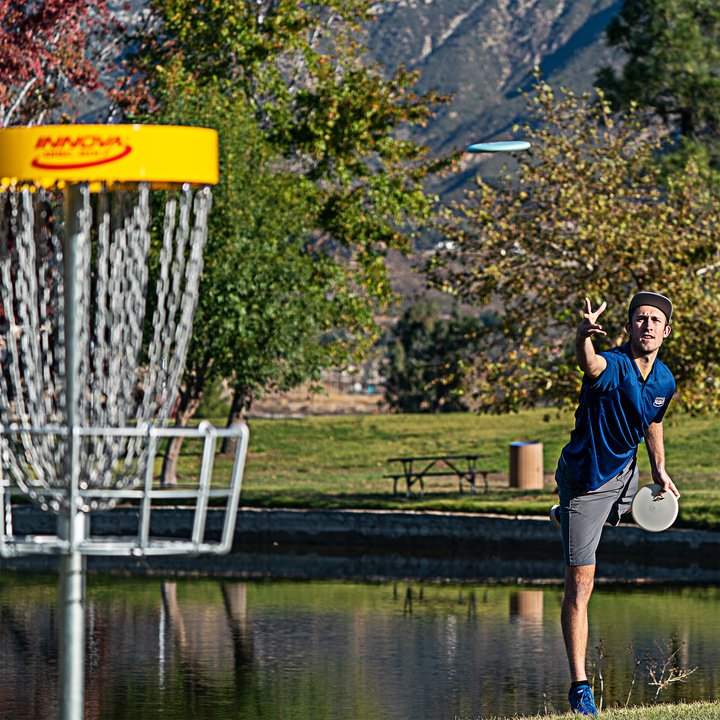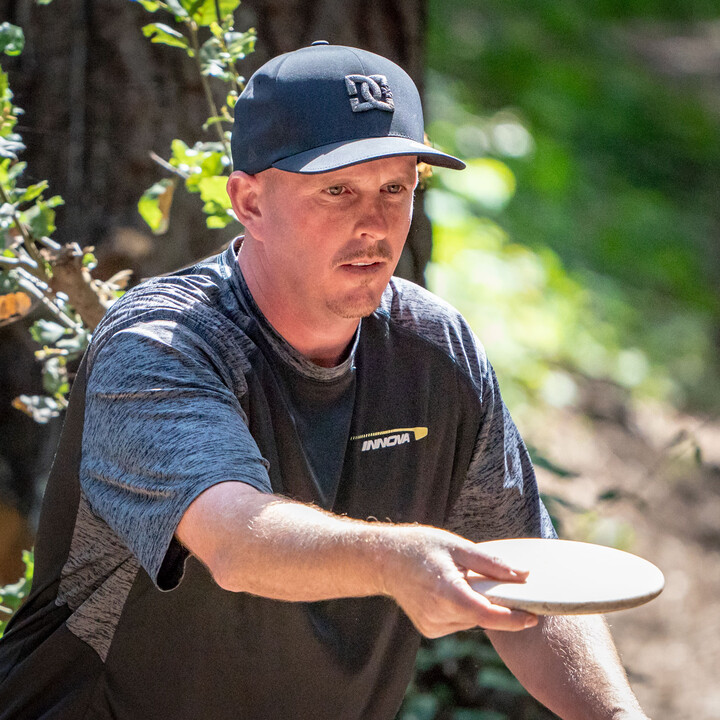Disc Golf Dictionary, Volume IV: Putting
No matter how far you can throw, you still have to make putts to compete at a high level. Putting is often the most stressful and technical part of disc golf. The greens are where major tournaments like the USDGC are won and lost.
Because putting is its own little ecosystem within disc golf, it has a lot of terminology you need to understand. We’re here to break down the words and phrases associated with disc golf putting.
 Putt—In purely technical terms, a putt is a stand-still throw within 10 meters or less. You would usually use a slower, blunt-edged putt and approach disc like an Innova Aviar. Some players may still use a standard or altered putting motion from outside the 10-meter circle that most would still consider a “long putt.”
Putt—In purely technical terms, a putt is a stand-still throw within 10 meters or less. You would usually use a slower, blunt-edged putt and approach disc like an Innova Aviar. Some players may still use a standard or altered putting motion from outside the 10-meter circle that most would still consider a “long putt.”
Holing Out—This is when you have officially “holed out” on a disc golf hole, with your disc having come to rest in the basket tray or the chains. The hole is only considered completed when each player has properly holed out.
Circle 1—This refers to the area within 10 meters (roughly 33.3 feet) directly around the basket. Once your disc is inside circle 1, you may not step through or let any part of your body touch the ground in front of your lie during or after your throw. You must demonstrate balance and bodily control until the disc has come to rest within the basket or chains. If not, you will be subject to a “foot fault” penalty.
Circle 2—This refers to the area within 20 meters (roughly 66.6 feet) directly around the basket. Many tournaments will mark off both circle 1 and circle 2 for player reference. Once you are outside circle 1 (within circle 2 or beyond), you are allowed to step or jump through after you release the disc.
Green—Some will refer to a disc golf green as another term for circle 1. In general, it is the terrain directly around the basket. When you hear someone talking about a “fast green,” they are referring to the ground itself. It may be sloped or have hard turf that leads to enhanced skips and roll-aways. A “slow green” might be one with relatively deep grass, sand, soft dirt or wood chips that will stop the disc faster.
Mini Marker Disc—Though you are not required to mark your disc when putting, most players will use a legal mini marker disc to place in front of their disc and gain a few extra inches on the next throw.
Foot Fault—Within circle 1, a foot fault is when any part of your body (foot, hand or otherwise) lands past your lie during or after releasing the disc. Outside of circle 1, foot faults can happen if you take an improper stance or your plant foot is not planted within the permitted area behind the disc or mini marker. A foot fault, if called and seconded by at least two members of your card, will add a one-stroke penalty to your score
Falling Putt—Another term for a foot fault within circle 1 where you step through or fall forward illegally and incur a one-stroke penalty throw.
Jump Putt—When you are outside circle 1, you are allowed to jump putt as long as your plant foot (or both feet) is still on the ground at the moment you release the disc. After the disc is released, the jump forward can provide extra momentum.
Step Putt—An alternative putting method for longer putts outside circle 1. For this throw, you step through with the foot that is not planted at the lie, again with an objective of gaining extra momentum on your putt.
[For more information on foot faults, falling putts and rules concerning step and jump putts, check out our article entitled “How to Avoid Falling Putts and Foot Faults.”]
Straddle Putt—A straddle putt is a style of putting stance where both feet are parallel with the basket, usually spread out somewhat to provide balance or stretched out in order to allow you to throw around an obstacle on the green (such as a tree or bush). Some disc golfers prefer to use a straddle-type putt for all putts.
Stagger Stance—An alternative to the straddle stance, this is when one foot is positioned somewhere behind the other to provide better balance or allow for a rocking motion that can help generate a little more momentum. Whether you prefer to straddle, stagger or take some other type of putting stance, there is no right or wrong answer. It’s all about figuring out what feels most comfortable to you for any given putting scenario.
Turbo Putt—Most players will use a traditional backhand motion for putting. Sometimes, you will see someone attempting a turbo putt. This is when you hold your disc above your shoulder with your fingers on the back of the rim. The disc is thrown with a pushing motion toward the target. It is a good utility putt when you have to putt over objects. Again, some players will use a turbo putt for all hole-outs. It’s just a matter of personal preference.
Spit-Out—Nobody ever likes to see spit-outs in disc golf, but they are just part of the game. This is when you hit the chains solidly on a putt (or any throw), but the disc does not catch in the basket tray. Chalk it up to bad luck or blame it on the basket!
Blow-Through—Another bad luck putting scenario where your disc hits the chains, but somehow slips through them all and out the back of the basket.
Roll-Away—This often happens when you hit part of the basket, but don’t make it. The disc may hit the ground, stand up on edge and roll away down a hill. Another bit of bad luck you may encounter anywhere on a disc golf course!
Comebacker—A comeback putt is when you miss your first putt and are left with a follow-up putt attempt. Feeling the need to make the comebacker and not burn another stroke will definitely add some more pressure during a round!
Tester—A tester is any putt that is outside your personal “comfort zone.” It’s one you should make most of the time, but the competitive situation adds a little pressure and tests your confidence.
Running It—When you are faced with a long putt or scary tester and you make an aggressive bid at making it. “Running It” is also a great new podcast with Innova Team Captain, Nate Sexton!
Lay-Up—The opposite of running it. This is when you don’t many any real attempt to make a scary putt. You simply toss your disc softly up close to the basket so you can tap it in.
Tap-In (or Drop-In)—When you are so close to the basket on a putt that you can simply drop it in the tray.
Hyzer Putt—This refers to a putting style where you throw the disc on a hyzer angle (with the disc tilted down and away from your body) and play the natural curve in the air to control your putt.
Anhyzer Putt (Anny)—This is the opposite of a hyzer putt, when the disc is tilted upward when you release it to enter from the left side of the basket on a RHBH putt. Some players prefer to putt most putts with an anhyzer release while others may only use it to get around obstacles.
 Spin Putt—A putting style where you impart more spin on the putt as you release the disc, usually with a goal to throw it on as straight a line as possible into the basket. A spin putt will generally enter the basket with more speed.
Spin Putt—A putting style where you impart more spin on the putt as you release the disc, usually with a goal to throw it on as straight a line as possible into the basket. A spin putt will generally enter the basket with more speed.
Push Putt—A putting style where your arm acts more as a pendulum and you “push” the disc out of your hand without much spin. It may float up and drop into the basket or wobble a little to catch the chains softly.
Spush Putt—Somewhere in between a spin putt and push putt style. Many disc golfers naturally have a “spush putt” that blends some elements of a spin putt and some elements of a push putt.
As you can see, there are numerous different putting styles you can try and plenty of different putting terms you may hear out on the disc golf course. Whatever terminology you want to use, putting is perhaps the most important part of the game. The good news is it’s pretty easy to practice and you can work hard to become a better putter over time.
